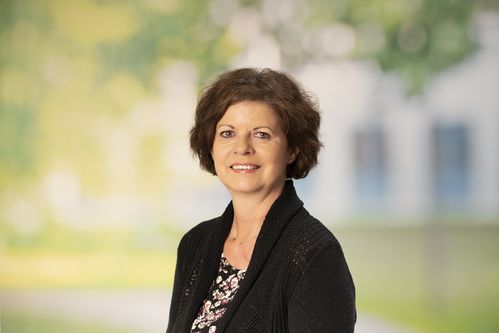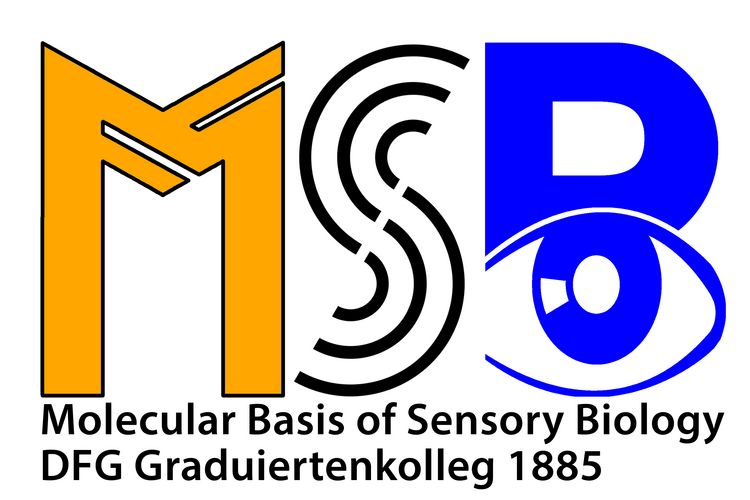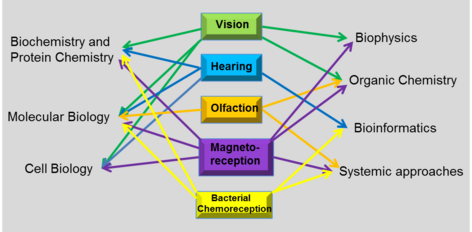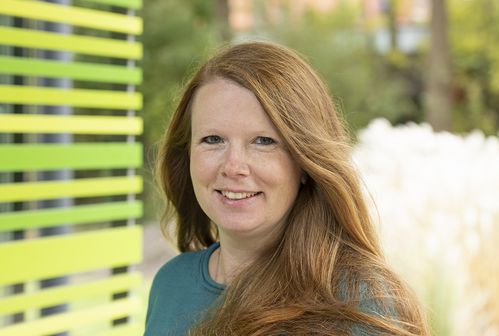Research Programme
Contact
Speaker of the RTG
Prof. Dr. Karl-Wilhelm Koch
Tel.: +49-(0)441-798-3640
Raum: W4 1-137
E-mail: karl.w.koch@uol.de
Scientific Management
Dr. Kristin Tietje
+49 (0)441 798-3882
Kristin.Tietje@uol.de
W10 0-007
Scientific Management
Anne Depping
+49 (0)441 798-2451
sensorybio@uol.de
V03 M 3-335

Finance and Administration
Gabriele Ahrens
+49 (0)441 798-3336
+49 (0)441 798-193336
gabriele.ahrens@uol.de
W4 1-167

Research Programme

Core research idea/ focus of the RTG
Sensory systems combine remarkable properties to achieve their physiological tasks.
They are extremely sensitive: mammalian rod photoreceptor cells respond to single photons,
olfactory sensory neurons recognize chemical stimuli requiring only a few thousand
molecules and weak geomagnetic fields provide orientation cues for a wide range of organisms
in the presence of distorting backgrounds. Thus, under normal environmental
conditions, sensory stimuli are perceived and processed in the presence of potential desensitizing
or interfering backgrounds. They are adaptive in the presence of stimulating
or distorting backgrounds and operate with high specificity under changing environmental
challenges. Sensory systems overcome these constraints by well-balanced adaptation
mechanisms and by combining high signal amplification rates with efficient control
systems. Important control elements are feedback loops and deactivation steps that operate
downstream from the primary sensory molecules.
The RTG will focus on molecular processes in sensory cells that mediate cell responses
to physical (photons, sound waves, magnetic fields) and chemical signals, and circuits
involved in the processing of these responses. We grouped our research concept in the
first funding period into three main topics: receptors, signal transduction and molecular
switches, which exhibit a mutual dependence (Figure 1) and we will keep these categories
as the basic framework of the RTG.

Integrative connection of research topics in the research programme
I. Receptor molecules
The first step in most sensory systems is a chemical and/or biophysical change within a single primary detector molecule in response to specific external stimuli. Research projects in this category deal with identifying and properly understanding sensory receptors and their activation processes. Main research topics are:
1. Identification, cellular localization and molecular characterization of receptor types with a
new function. For example, cryptochromes are putative receptor candidates in radicalpair based magnetoreception, of which at least four different isoforms are present in the retina of night-migratory birds. However, so far we are still lacking basic information on the tissue expression, intracellular distribution and function in the retina. Compass orientation of coral reef fish is a further unsolved sensory phenomenon that will be addressed by the RTG. It depends on a sun compass and magnetic compass, but the molecular receptor identity is unknown. Opsins in teleost fish could serve as receptors for linearly polarized sun light thereby providing orientation cues.
2. Investigating the relevance of protein domains for receptor activation and ligand recognition;
understanding the functional role of critical regions in the primary protein structure of a receptor molecule. Membrane-bound guanylate cyclases can operate as receptors or as part of a signalling cascade depending on the subtype and cellular expression pattern.
We will ask, whether sensory and non-sensory guanylate cyclases are activated by the same conformational mechanism. A further major challenge in receptor research is to understand how structurally similar molecules are distinguished on the receptor level to trigger different pathways of signalling. This fundamental question will be addressed using a bacterial model system and studying chemoreception of different
aromatic compounds.
3. Receptor function in a cellular network. We aim to investigate downstream cellular responses, if a key receptor is missing or non-functional within a cellular network by recording from ganglion cells in retinae that lack glutamate receptors in horizontal cells. These studies will be complemented by studies on the light-dependent expression of receptor proteins and connexins in the mouse retina.
4. Employing model structures or model compounds to investigate lighttriggered charge separation processes with high spatial and spectral resolution (nanometer length scale and femtosecond time scale).
II. Signal transduction
Biological signal transduction pathways are complex networks of interacting proteins that result in signal amplification, signal control by feedback reactions and signal turn-off by deactivation reactions. Main research topics are:
1. Identifying components and building blocks of signalling pathways, investigation of protein
signalling complexes focussing on protein-protein and protein-membrane interactions. Interacting protein pairs or multi-protein complexes in signalling pathways need to be characterized in qualitative and quantitative terms. We have a range of experimental techniques at hand to investigate interaction processes by quantitative biochemical and biophysical approaches. This will include recently identified proteins in well-described signalling pathways (RD3 protein in photoreceptor cells), but also the expression and interaction patterns of connexins, glutamate receptors and cell adhesion molecules in horizontal cells, cryptochromes in the avian retina, and of the Retinitis Pigmentosa GTPase Regulator, which are largely unknown. The RTG aims at identifying unknown interacting molecules.
2. Understanding protein dynamics of larger protein complexes and investigating which protein domains and regions are important for function. These structure-function studies will employ fluorescence studies, surface plasmon resonance and Raman spectroscopyon isolated proteins or proteins in a cellular network (e.g. Ca2+-sensors like GCAP proteins,
protein domains of membrane-bound guanylate cyclases, regulators of connexin).
3. Dysfunction of protein networks causing hearing loss and retinal degeneration. In deciphering the molecular basis of the visual signalling cascade, investigations of the impaired system have been particularly enlightening. The molecular mechanisms underlying retinal pathogenesis includes hereditary and non-hereditary pathways. The RTG will focus on mainly two aspects of sensory dysfunction: retinal dystrophies that are associated with ciliary defects (e.g. mutations in the Retinitis Pigmentosa GTPase Regulator in the retina) and mutations in microRNAs that correlate with hearing loss and malformation of the auditory system. The latter studies will be extended to the visual system by investigating the morphological consequences and changes in protein expression patterns in a mouse line harbouring the corresponding microRNA point mutation.
4. Intracellular transport and trafficking and their links to signalling processes. External stimuli can regulate protein trafficking and intracellular reorganization in sensory cells (e.g. light-triggered transport processes in photoreceptor cells). Retinal diseases can be linked to the impairment these transport processes for example mutations in the mammalian RD3 protein distort trafficking. Ciliary model systems will provide an experimental model system for investigating trafficking in sensory cells. In order to investigate more generally the functional role of the RD3 protein, its expression in zebrafish photoreceptors and its putative interaction with zebrafish specific guanylate cyclases will be studied in heterologous expression systems and cell culture.
III. Molecular switches
Molecular switches respond to external stimuli and can operate in proteins of signaling cascades. For example, they trigger at the receptor level the start of a sensory signaling cascade. Switch mechanisms in voltage- and ligand-gated ion channels allow the precise passage of ions. Intracellular second messengers (e.g. cAMP, cGMP, Ca2+) bind to proteins and transform the target into an active state. Main research topics are:
1. Basic physical principles of switch mechanisms using fluorescently labelled proteins or model substances. Activating or inhibiting regulatory proteins will be labelled sitespecifically by fluorescence dyes (purpose-directed design and synthesis of dyes). These approaches should clarify how stimuli of second messengers trigger conformational changes, which operate as molecular switches to turn on or off downstream activation processes.
2. Posttranslational modifications allowing phosphoryl- or myristoyl-switches in sensory cells. Benchmark signaling pathways like the rod phototransduction cascade consists of many proteins, for which the phosphorylation and acylation status is essential for being fully active or inactive (e.g. rhodopsin, G-proteins, Ca2+-sensors). But we lack this information for most other sensory cell systems (retina horizontal cell) and even for the different cone cell types, functional consequences of posttranslational modifications are largely unknown.
3. Transformation of biological principles into technical systems (e.g. artificial photoreceptors). An important strategy for achieving a microscopic understanding of switch mechanisms in biological macromolecules will be the study of small organic molecules as model systems.
Considering the complexity of the signaling molecules and pathways described to date, there is also a need to reduce this complexity initially by understanding common basic principles. A comparative survey across the different senses has only rarely been attempted. The RTG will bring together the necessary diversity of scientific backgrounds to promote the mutual exchange of ideas, concepts and methods to achieve a more comprehensive understanding of the molecular basis of sensory systems.
This need for integration resulted in our decision to make the mutual exchange of biological and/or biophysical concepts the common core of the general research aims and is also a central part of our qualification concept. The participants and applicants of the proposed RTG have different scientific background with respect to their special fields of research and their methodological expertise (summarized in Figure 2).

Figure 2: Sensory systems and methodological approaches in the proposed RTG. Arrows indicate main connections between senses and applied methods that are based in the indicated field.



